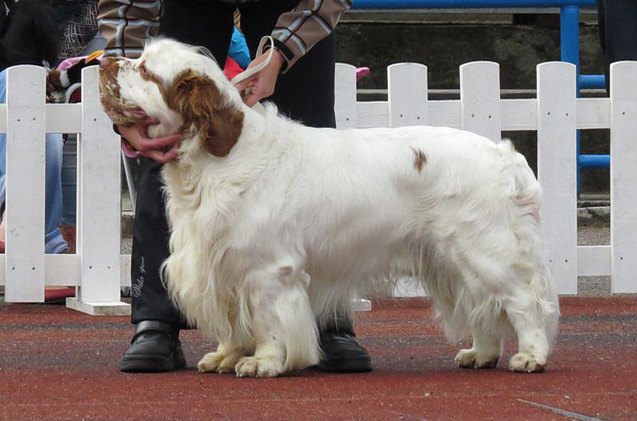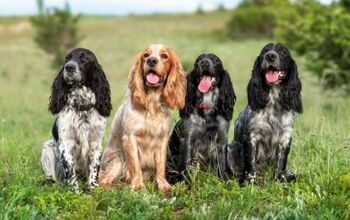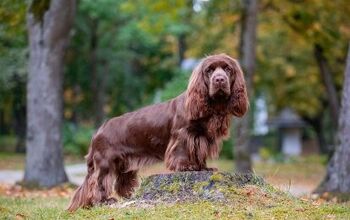Clumber Spaniel


About Clumber Spaniel
The largest of all spaniels, the Clumber Spaniel is a dog fit for a king. And indeed, much of the breed’s early history centers around French and British nobility.
Bred to be a gundog that specializes in hunting in heavy cover, the Clumber Spaniel has the long, soft coat characteristic of all spaniels. Most Clumbers are white in color, while some specimens display brown, lemon or orange markings. It is fairly powerfully built dog with heavy bone structure and a massive head. This large muzzle enables the Clumber Spaniel to retrieve all types of game. The Clumbers have ‘melting’ heads and their faces take on a sleepy, mournful expression.
Although not as fast as most other breeds of spaniels, the Clumber has great stamina and is able to trot along at a slow gait for hours on end. It is also a highly intelligent dog capable of independent thinking. These characteristics make it an excellent hunting dog; a task the breed was used for prominently amongst the British aristocracy. They are also gentle and loving and make excellent pets as well.
The largest of all spaniels, the Clumber Spaniel is a dog fit for a king. And indeed, much of the breed’s early history centers around French and British nobility.
Although their exact history is unclear, it is widely believed that Clumber Spaniels originated from the gun dogs bred by the French nobility in the early 1600s. One theory of origin goes onto state that the French Duc de Noailles, under threat from the French Revolution, gave away his prized kennel of hunting dogs to the Duke of Newcastle at Clumber Park. It is believed that the breed was developed and perfected here by the Duke’s gamekeeper William Mansel. However, it is certain that the breed derives its name from Clumber Park.
The breed enjoyed great patronage from various British Royals, including Queen Victoria’s consort Prince Albert and his son King Edward VII. Queen Victoria mentions the breed in her diary as follows:
“Walked out directly after breakfast before Albert went to shoot. He had his 7 fine Clumber Spaniels with us and we went into the Slopes, with such a funny old Gamekeeper, Walters, in order that I should see how the dogs found out their game. They are such dear, nice dogs.”
The breeding of Clumber Spaniels was restricted to British nobility up until the mid 19th century, and was halted completely during World War I. This caused their numbers to drop drastically and it took the efforts of King George V to rejuvenate the breed.
It is believed that the Clumber Spaniel’s ancestry includes blood from the now extinct Alpine Spaniel, the Basset Hound and the St. Bernard.
Clumber Spaniel puppies are highly active and often have voracious appetites. Their metabolism slows down significantly once the dogs reach adulthood and should be fed on two meals of high quality dog food a day.
Clumber Spaniels are hard working, intelligent dogs and are eager to please.
Clumber Spaniels are hard working, intelligent dogs and are eager to please. Therefore most positive reinforcement techniques work excellently with the breed. They can be trained to hunt and retrieve game quite easily.
Clumber Spaniel males range in weight from 70-85 pounds.
Clumber Spaniels are regarded as one of the more laid-back breeds of spaniels and have gentle, easygoing temperaments. They are however highly intelligent and independent, and may turn willful when not given proper leadership. Like most intelligent working breeds, Clumber Spaniels respond well to the leadership of calm, assertive owners.
Clumber Spaniels are playful and get along excellently with children. They also coexist peacefully with other dogs and other animals. They can however be aloof with strangers and efforts should be taken to socialize them early on in life.
These dogs are not barkers and do not make good guard dogs.
Clumber Spaniels are a generally healthy breed of dog. However, they are prone to ailments such as hip dysplasia elbow dysplasia, hypothyroidism and von Willebrand’s disease.
A well cared for Clumber Spaniel will enjoy a lifespan of 10-12 years.
Clumber Spaniel puppies are highly playful and have a great deal of energy. They however slow down significantly as they age and aren’t very active as adults. This makes them unsuitable for active, athletic owners that enjoy jogging and hiking with their dogs. However, they do require at least an hour of walking exercise each day. They also enjoy carrying things in their mouth as it gives them a meaningful task to be engaged with.
Clumber Spaniels are regarded as one of the more laid-back breeds of spaniels and have gentle, easygoing temperaments.
The Clumber Spaniel was one of the first 9 breeds to be recognized by the AKC in 1884. The AKC has this to say about the breed: “One of the original nine breeds registered by the AKC, the Clumber Spaniel’s long and low build is particularly unique among spaniels. Although not as speedy as other sporting dogs, the Clumber will work all day, trotting along in his signature slow, rolling gait. He may appear dignified and pensive, but he possesses great enthusiasm for both work and play. The breed possesses a beautiful white coat and may have lemon or orange-colored markings.”
Like all spaniels, the Clumber Spaniels coat is thick, straight and soft to the touch. They do shed quite a bit and should be groomed regularly with a brush and comb. Some trimming of the coat may be required on occasion.
Clumber Spaniel puppies are highly active and will romp around happily for the most part of the day. Their training should begin early and they should be socialized with other dogs and humans as early as possible.
Photo credit: Томасина/Wikimedia; Pleple2000/Wikimedia

Amy Tokic, Editor of PetGuide.com, is a passionate animal lover and proud pet parent of Oscar, a Shih Tzu/Chihuahua cross, and Zed, a Japanese Chin. Her love of animals began in kindergarten, when she brought her stuffed dog Snoopy into class with her every day. Now, she writes about her adventures in pet ownership and tirelessly researches products, news and health related issues she can share with other animal enthusiasts. In her free time, Amy loves perusing used book and record stores, obsessing over the latest pet products available and chasing squirrels with wild abandon (a habit attributed to spending too much time with her pooches).
More by Amy Tokic

























